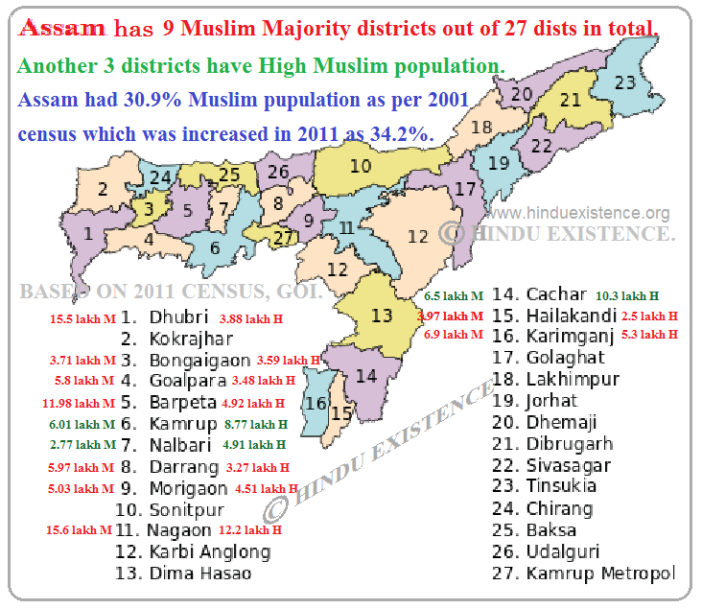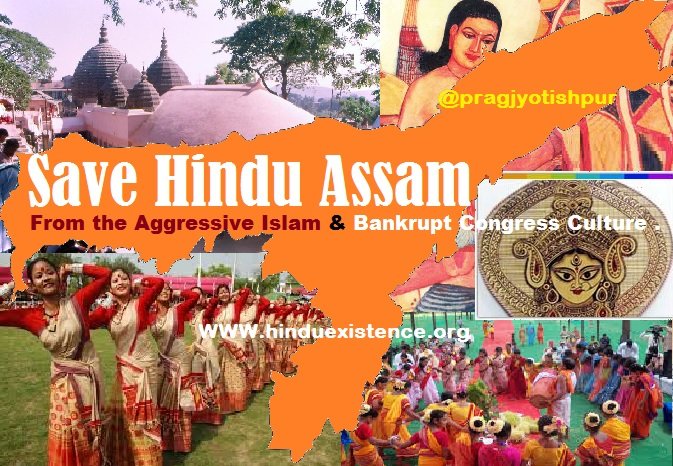Is There A Solution In Sight For Assam’s Demographic Crisis? An Analysis


Assam serves as the gateway to the other states of the Northeast and also shares an international boundary with Bangladesh and Bhutan. Till 1826, Assam was the stronghold of a fiercely independent Ahom kingdom which, with all its might, thwarted multiple invasion attempts by the Mughals, that otherwise affected most other parts of India. Numerous tribes and communities have prospered and inhabited the plains and hills of Assam since the medieval times, so much so that the state today represents a diverse and unique cohabitation of around 115 different ethnic communities, supplemented by dozens of unique and endangered languages.
Unfortunately, many of the indigenous communities of Assam today number fewer than 10,000 people! They are now at the grip of a looming threat of socio-cultural extinction chiefly propelled by immigration from Bangladesh. A senior advocate of the Supreme Court of India, Upamanyu Hazarika, had earlier informed that there exist a few villages in Darrang district of Assam where immigrants not only outnumber the natives but the latter have been pushed into ghetto-like dwellings in their own ancestral abode. The ramifications of this unabated immigration of people have now come to severely bear upon the vital statistics of the state in terms of basic self-sufficient sustenance.

The Census data of 2011 reveals a steep rise in the migrant population in nine border districts of Assam. While Muslims constituted 30.9% of the population in 2001, this share jumped to 34.2% in 2011. A Report on ‘Illegal Migration into Assam’ submitted to the President of India by the then Governor of Assam Lt. Gen (Retd.) S.K. Sinha in 1998 clearly showed that the Muslim population of Assam rose by 77.42% in 1991 from what it was in 1971. Comparatively, in the same period, the Hindu population had risen by a mere 41.89%. Sheikh Mujibur Rehman, the founding-father of Bangladesh, clearly wrote in his booklet Eastern Pakistan: Its Population and Economics,
“Because Eastern Pakistan must have sufficient land for its expansion and because Assam has abundant forests and mineral resources, coal, petroleum, etc. Eastern Pakistan must include Assam to be financially and economically strong.”
The immigration issue has now become a question of existential survival for the common people of Assam. The Assam Movement (1979-85), the Brahma Committee Report on Land Rights, Upamanyu Hazarika’s one-man Commission on border-sealing, NRC, the anti-CAA movement and most recently, the Clause 6 recommendations of the Assam Accord (1985) – all had the immigration issue as a contributory factor at the very least. In fact, the Upamanyu Hzarika Commission Report even mentioned that illegal immigration from Bangladesh is threatening to reduce the indigenous population of Assam to a minority in their own homeland by the year 2047. Quite unfortunately, these claims, when made by the common Assamese people, have been repeatedly slandered by a section of the mainland press and as well as the academia as ‘xenophobic’, and sometimes even as ‘Islamophobic’!

This trend gained further traction during the process of finalising of the National Register of Citizens (NRC), when it came to be portrayed in front of the national and international audience as an exercise of disenfranchising the Muslim population of Assam and thus robbing them of their citizenship rights, by declaring a vast majority of the community as illegals and non-citizens. Although the NRC was at first initiated during the previous Congress government in the state under the leadership of Assam’s former CM Tarun Gogoi, but the fact that the preparation of the NRC was undertaken on a serious note under the BJP government, aided by the moral support of the RSS, only helped establish this image. It was this one-sided and hypocritical narrative that quite comfortably brushed aside the truth that it was only citizenship and not religion that formed the basis of inclusion versus exclusion in the NRC.

Interestingly, when the final draft of the NRC was released, it faced vehement criticism from all fronts of the Assamese society and was rejected by all stakeholders. But, the reason that was put forward by this particular nexus in question was that the ruling BJP rejected it primarily because of the exclusion of many Hindu Bengalis. The fact that the names of a large section of the indigenous population of the state were also excluded from the final NRC list featured nowhere in their so-called “academic” writings and statements. It is this lobby of agenda-peddling journalists, academicians, activists and so-called “jatiyotabadi netas” too, who have frequently ridiculed the concerns of the common people as fool-hardy opinions based on an ultra-jingoistic nationalist ideology! And, this they have always been doing through selective interpretation and re-interpretation of data while conveniently skipping over some brutally honest facts.

For instance, they often like to refer to S.K. Sinha’s report on illegal migration as unreliable, on the ground that S.K. Sinha quotes a 1931 report submitted by a British civil-servant C.S. Mullan, thus making it outdated. But, they have never bothered to mention about the fact that Sinha’s report also made use of updated data from the Intelligence Bureau and Census Reports showing an unnatural increase in the population growth rate of multiple constituencies in Lower Assam. Some have even went to the extent of terming Sinha’s report as the basis of Assamese nationalist ideology, while the truth is that the report had more to do with national security than the protection of the rights of the common Assamese. Curiously enough, Sinha had mentioned in his report that the consequences of large-scale immigration need to be emphatically stressed upon and no misconceived and mistaken notions of secularism should be allowed to come in the way of doing so.

One of the darkest episodes in the modern history of Assam is the Nellie massacre in which thousands of people of East Bengali origin were slaughtered at the peak of the anti-foreigners’ movement in Assam. While there can be no disagreement that the incident in itself was a shameful event irrespective of the perpetrators, multiple discussions have taken place in the subsequent years regarding the chain of events that culminated in this deadly massacre. One of them is the settling of a large number of Bengali Muslims in lands whch originally belonged to the janajatis and the consequent anger among the adjoining Tiwa villages due to illegal encroachment into their ancestral lands. An uncontrolled burst of resentment festered soon after. But, the immigration-favouring nexus of academicians and media houses seems to have very conveniently omitted these true historical facts, thereby putting the entire blame of the massacre onto a vague umbrella term of ‘Assamese nationalists’.
This lobby is also at the forefront of organising prominent national and international conferences, seminars, webinars, and conventions at frequent intervals in not only Assam but also across different cities of India. By taking recourse to half-truths and in some extreme cases even pure and blatant lies, they are responsible for vilifying the NRC process in Assam as a ‘xenophobic exercise’ aimed at making a large section of the people stateless. Whenever the issue of illegal immigration is raised, they try to emphasise on the “economic” role of these immigrants in the Assamese society, ignoring the larger concerns of internal security and the massive demographic and cultural change that has been unleashed in several districts of Assam, especially the border districts of Dhubri and Barpeta in Lower Assam.
Another serious danger knocking at the doors of not only over Assam but also that of the entire country is of a “second partition” with the complete or partial loss of Lower Assam to Bangladesh, aided and abetted by international Islamic terrorist groups and madarsas, sponsored by Pakistan’s ISI. In the words of S.K. Sinha himself, the former Governor of Assam,
“The rapid growth of international Islamic fundamentalism may provide the main driving force for this demand. The loss of Lower Assam will sever the entire North-East from the rest of India and the rich natural resources of that region will be lost thereafter.”
It is better that we shed our romance with political correctness sooner, and accept the ugly reality of the never-ending migration of Bangladeshis into Assam, assisted by the blessings of political leaders. The economic and political survival of these illegal immigrants over the years has been faciliated through dubious documents such as forged Voter ID cards, ration cards, etc. with the blessings of a corrupt bureaucrat-politician nexus. Besides the huge demographic shift that it has created in several districts of the state, the twin menaces of illegal immigration and land encroachment have now become a serious threat for the culture and civilisation of Assam.

Today, a demographic and socio-cultural crisis engulfs most of the Hindu religious institutions of Assam. As per a newspaper report published way back in September 2010, more than 7,000 bighas of land belonging to 39 Sattras of Assam are in the grip of illegal encroachers of suspicious nationality. This was the opinion of the then advisor of the Axom Sattra Mahasabha (parent organisation of all the Sattras of Assam) Sri Sri Bhadkrakrishna Goswami. It was during this time that the Gauhati High Court had also directed the state government to free Sattra lands from illegal encroachment. In this respect, the Deputy Commissioners and Superintendents of Police of the districts under which these Sattras fell, had been asked to evict the encroachers at the earliest (Deccan Herald, september 17, 2010).
Among the worst-affected ones are the Ram-Rai Kuti Sattrasal Sattra in Dhubri, Rampur Sattra in Nagaon, Adi-Alengi Sattra, Barpeta Sattra, Kobaikata and Alipukhuri Sattras in Morigaon district, and a few more. For instance, the Ram-Rai Kuti Sattra in Dhubri has almost 1,000 bighas of its land occupied by illegal encroachers, of which around 500 bighas are located in the ‘No Man’s Land’ along the Indo-Bangladesh border. Assam CM Sarbananda Sonowal, while visiting the Bardowa Sattra in Nagaon district of central Assam after it was cleared of encroachers in September 2016, had clearly said that the eviction process will continue till all the 700 Sattras across the state are made free from illegal occupants. However, it’s still a long way to go!

The Supreme Court of India, the country’s highest judicial authority, has also taken note of this crisis and termed it as an “external aggression” in the case of Sarbananda Sonowal vs. Union of India (2005). The court clearly stated – “This being the situation, there can be no manner of doubt that the state of Assam is facing ‘external aggression and internal disturbance’ on account of the large-scale illegal migration of Bangladeshi nationals. It, therefore, becomes the duty of the Union of India to take all measures for protection of the state of Assam from such external aggression and internal disturbance as enjoined in Article 355 of the Constitution. Having regard to this constitutional mandate, the question arises whether the Union of India has taken any measures for that purpose.”
Thus, Assam’s unending problem of illegal immigration continues to be a deeply complex one in all spheres of its social, political and economic lives. A nefarious agenda that swears by the liberal logic of tolerance and secularism is to be blamed for much of the problems that the state is facing today! It amounts to denigrating the genuine concerns of a community for basic survival against an ever-expanding religious cult, its goal of self-preservation and protection of its culture, as guaranteed by the Constitution of India.
A few possible solutions to the problem:
References:
DISCLAIMER: The author is solely responsible for the views expressed in this article. The author carries the responsibility for citing and/or licensing of images utilized within the text.
